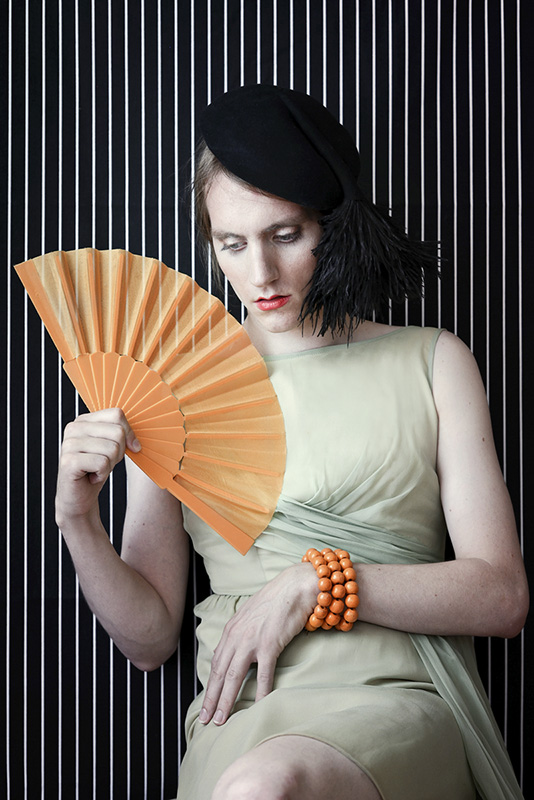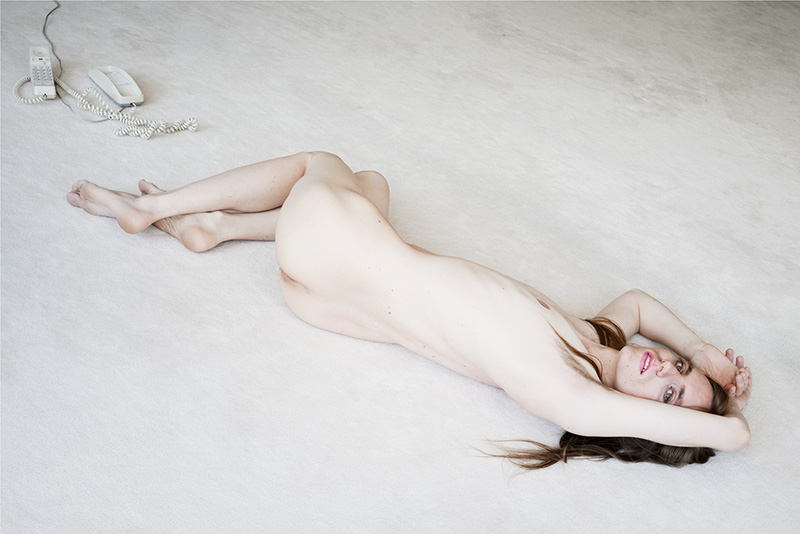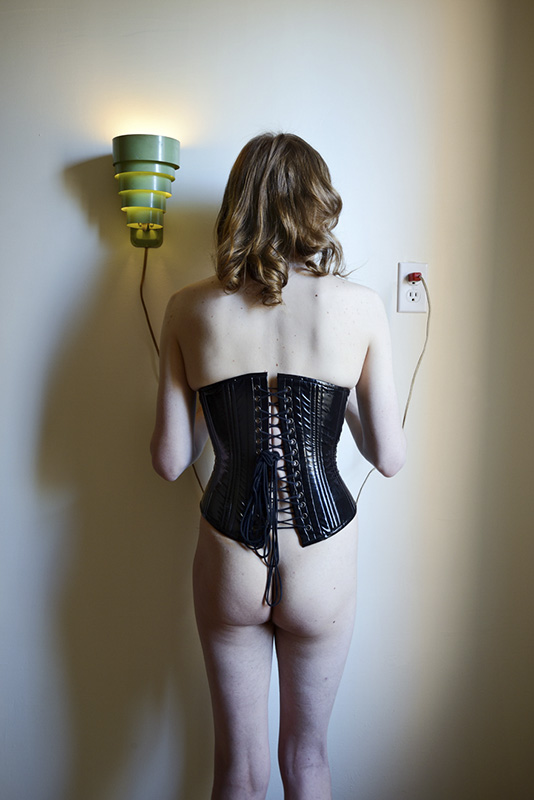(English version below)
Eleganza, sensualità, delicatezza …racchiuse in un movimento fra maschile e femminile che non cerca l’ambiguità o la provocazione, ma vuole piuttosto portare a compimento un “essere”.
Questa serie di ritratti sono un incontro fra un uomo e una donna intorno all’espressione della femminilità. Ma la femminilità in questione è quella dell’uomo, che sente il desiderio profondo di vestire abiti femminili. E Lissa Rivera, fotografa newyorkese, propone all’amico BJ di usare la fotografia come spazio per sperimentare ed esprimere questa sua dimensione. Nasce così il progetto “Beautiful boy”, in cui BJ posa ora in interni, ora in esterni oppure in set appositamente costruiti. Lissa e BJ danno così vita ad un immaginario femminile ogni volta diverso. Il travestimento, però, non cela il corpo maschile, ma anzi lo svela e lo rivela. Spesso infatti compare il petto piatto, senza che questo tolga nulla alla femminilità del corpo, che si sprigiona nelle pose e nelle movenze del corpo, dando vita ad un “beautiful boy”. Un’espressione che forza il linguaggio, adoperando “impropriamente” l’aggettivo beautiful, usualmente riferito solo alle donne, mentre per gli uomini si dovrebbe correttamente dire handsome. Ma qui siamo oltre ogni distinzione.
L’incontro che si realizza in “Beautiful boy” diventa infine una storia d’amore: i due amici, la fotografa il modello, diventano amanti e collaboratori.

Nella tua vita, Lissa, quali figure femminili sono state particolarmente importanti per la tua personale definizione di “femminile”?
Sono sempre stata interessata a quello che facevano i maschi e rifiutavo gli obblighi tipici della femminilità. Da adolescente una della mie canzoni favorite era la cover di Lola delle Raincoats. Lola è una canzone scritta da Dave Davies dei Kinks, che racconta di un uomo che si innamora di una donna trans. Quando le Raincoats, una band di sole ragazze, la suonavano, non cambiavano i pronomi, cantandola da una prospettiva maschile. Io insegnai le parole alla mia sorellina e insieme la cantavamo all’infinito quando i nostri genitori erano fuori a fare la spesa. Durante il carnevale io cantavo Lola al karaoke davanti agli agricoltori che bevevano birra e agli alcolizzati della città.
Ho sempre amato le figure maschili che erano femminili, specialmente nella musica. E mi rese molto felice vedere Female Trouble di John Water. Fu come connettermi alle malfamate parole di Edith Massey “il mondo degli eterosessuali è una vita malata e noiosa”. Penso di aver sempre preferito l’androginia e il queer. I sono una donna cis-gender in apparenza, ma la mia personalità è decisamente più complessa. L’androginia mi è sempre sembrata più attraente del maschile e del femminile. Mi sento più a mio agio con uomini femminili e donne mascoline.
Per quanto riguarda la tua cultura visuale, quali personaggi e personalità hanno ispirato il tuo immaginario femminile?
Poiché la femminilità non mi veniva naturale, cominciai da giovane a studiare fotografie e film per imparare come essere una ragazza. Penso che tutte le persone lo facciano. Il film Fino all’ultimo respiro di Jean-Luc Godard mostra bene questo processo: il protagonista è attratto dalla persona di Humphrey Bogart, di cui incorpora gli atteggiamenti nella propria mascolinità.
Il ‘femminile’, nelle mie fotografie, è in continua evoluzione. Sento che il concetto di femminilità evolve con le immagini che vediamo. Questa è la ragione per cui la moda non è costante: gli uomini tendono a copiare le immagini intorno a loro e questo crea dei “trend”. Se si guarda un’immagine di Catherine Deneuve, si può desiderare di essere come lei. La settimana successiva, vedendo Bridget Bardot, si può segretamente immaginare di camminare come lei o di passare all’eyeliner. Ho la sensazione che le moderne bacheche di Pinterest o Instagram siano come una mappa del desiderio femminile espresso attraverso l’immagine. Mi piacerebbe che le femminilità che noi (io e BJ) esploriamo si espandessero mano a mano che esploriamo i nostri desideri, come una collezione digitale in crescita.

Avete delle connessioni con il mondo trans e queer?
L’incredibile creatività e l’attivismo delle comunità queer e trans newyorkesi sono di grande ispirazione per noi, e apprezziamo e onoriamo le tante persone che prima di noi si sono spese così tanto per aprire la nostra società e renderla più accettabile e aperta. Per quanto ci riguarda, riversiamo le nostre idee nella nostra arte, che è il nostro veicolo per esprimere le nostre convinzioni riguardo il genere e la libertà.
In seguito al progetto ti risulta ora più facile, BJ, indossare abiti femminili nella vita quotidiana?
Sì e no. Certamente mi sento più a mio agio nella mia pelle, e più sicuro di me nel modo di presentare la mia identità di genere. Indosso abiti da donna in privato quasi tutti i giorni e in pubblico molto di frequente. Ma allo stesso tempo ciò che mi trattiene dall’usarli nella vita quotidiana non sono ragioni interiori ma esteriori, e sfortunatamente vanno oltre la capacità mia e di Lissa di cambiarle. Lo stress di dover scegliere quale bagno pubblico usare quando la tua rappresentazione di genere è ambigua, dovendo affrontare l’imbarazzo che si manifesta nel volto e nel linguaggio del corpo dei presenti, e il sempre presente timore di aggressione e violenza rendono la non conformità di genere nella vita quotidiana molto ardua!
Da quando abbiamo iniziato il progetto mi sono spostato verso un modo di presentarmi più androgino, ed è stato uno passo molto positivo.
Infine, nella tua esperienza, BJ, quanto i diversi abbigliamenti, maschili o femminili, influenzano i tuoi comportamenti e atteggiamenti?
Non hanno un grande impatto. Io ho sentimenti e atteggiamenti prettamente femminili indipendentemente da come vesto e spesso vengo scambiato per una donna anche quando indosso abiti maschili o quando rispondo al telefono.
Il progetto completo è disponibile nel sito di Lissa Rivera



English version
Elegance, sensitivity and sensuality are given off from the tension between femininity and masculinity. A tension that is not ambiguous or provoking, but aims at the completeness of a “being”.
The portraits we are dealing with come from the encounter of a man and a woman around the expression of femininity. Not that of the woman, but the one of the man who likes and desires wearing dresses. Lissa Rivera, a New York based photographer, suggested her friend BJ to use the camera to create places and times for him to experiment and express his female dimension. That’s the start of “Beautiful boy”, in which BJ poses dressed-up indoor, outdoor or in staged sets. BJ and Lissa give life to a feminine imaginary that changes in every portrait. The dressing-up is not a camouflage of the male body, but on the contrary is a way to reveal it. And the flat breast is not the denial of BJ’s femininity, which instead comes out from the attitudes of the entire body.
And thus a beautiful boy comes to life and the friendship, from shooting to shooting, becomes a love story and the two friends become partners and lovers.
In your life, Lissa, which feminine figures were especially important, and why, for your personal definition of “feminine”?
I was always interested in what the boys were doing; I disliked the obligations of femininity. As an adolescent, one of my favourite songs was the cover of Lola by the Raincoats. Lola is a song written by Dave Davies of the Kinks about falling in love with a trans woman. When the all-girl band the Raincoats sang it, they did not change the pronouns, they sang it from the male perspective. I taught my little sister the words and we played it on repeat while my parents were out shopping. At the carnival in my small, rural town, I sang Lola in karaoke to all the beer-drinking farmers and town alcoholics.
I loved male figures that were more feminine, especially in music. When I discovered John Water’s film Female Trouble it made me so happy. I connected to Edith Massey’s infamous words, “the world of the heterosexual is a sick and boring life.” I think I have always preferred androgyny and queer things. I am a cis-gendered woman on the outside, but my personality is a bit more complicated. Androgyny always seemed more attractive to me than masculinity or femininity. I feel most comfortable with feminine men and bawdy women.
As for your visual culture, Lissa, what characters/personalities inspired your feminine imaginary?
Because femininity did not come naturally to me, I began to study photographs and movies to learn about how to adapt to being a girl at a young age. I think all people must do this. The movie Breathless by Jean-Luc Godard illustrates this well—the protagonist is attracted to the persona of Humphrey Bogart, whose mannerisms he incorporates into his own masculinity.
The femininities in my photographs are always evolving. I feel that conceptions of femininity evolve with the images we see. That is why fashion is not constant—humans tend to copy images that are around them and this creates ‘trends.’ If you see an image of Catherine Deneuve, you may feel a desire to be like her. The next week you see Bridget Bardot, and then you might secretly imagine walking like her, or perhaps switching to liquid eyeliner. I feel that contemporary Pinterest boards are like a map of feminine desire expressed through imagery. I want the femininities we explore to expand as we explore our desires, like a growing digital collection.
Does the two of you have any connection with the trans/queer world?
The incredible creativity and activism of New York’s queer and trans communities are a huge inspiration to us, and we appreciate and honor the many people who have gone before us and done so much work to open up our society and make it more accepting and open. For us, we pour our ideas into our art, which is our vehicle for expression and for our beliefs about gender and freedom.
Is it easier now for you, BJ, after the project, to wear woman dresses also in his daily life?
Yes and no. I definitely feel more comfortable in my skin, and more confident about my gender presentation. I wear dresses all the time, in private almost every day after work and in public fairly frequently. But at the same time, the things that really hold me back from wearing dresses in my daily life are not internal but external, and unfortunately they are outside of my and Lissa’s power to change. The stress of having to choose which public bathroom to use when your gender presentation is ambiguous, the visible discomfort that you see in some people’s faces and body language, and the ever-present fear of harassment or violence make gender non-conformity in daily life really hard! Since we started the project I have been moving towards a more androgynous presentation in my daily life, which has been a positive step.
In your own experience, BJ, how much does it affect your behaviour wearing dresses or clothes?
It doesn’t have a very big effect. I have a fairly feminine affect no matter how I’m dressed, and I often get taken for a woman even when I’m dressed in men’s clothes, or when I’m answering the phone.
To know more about Lissa and the project: